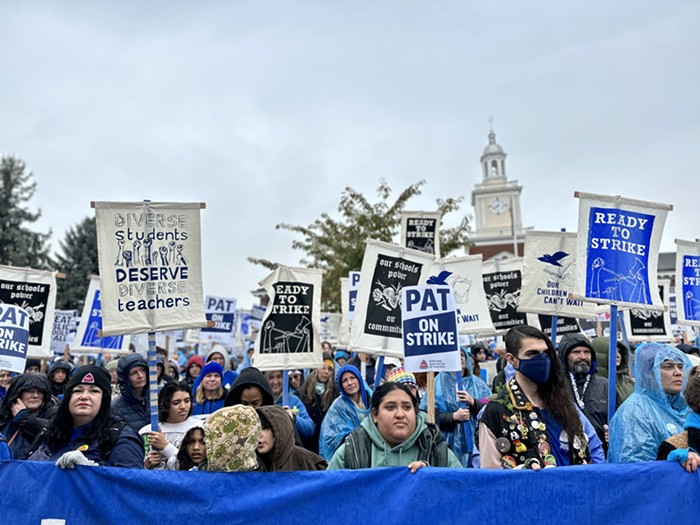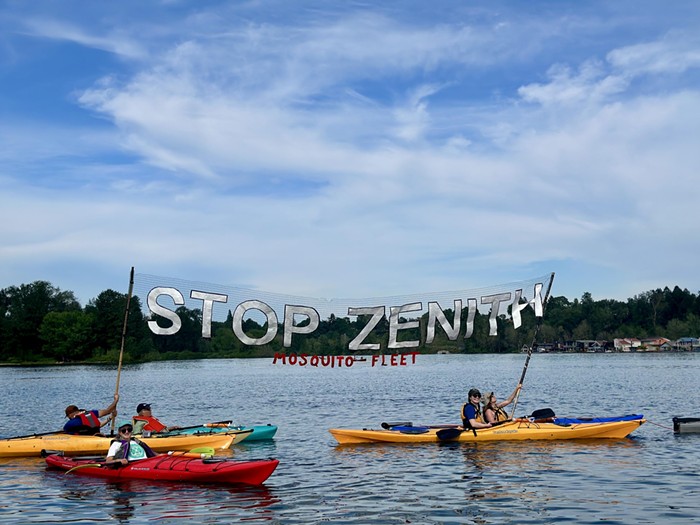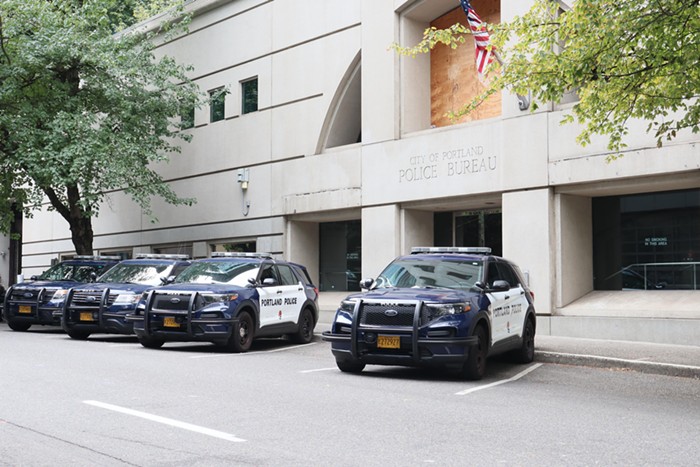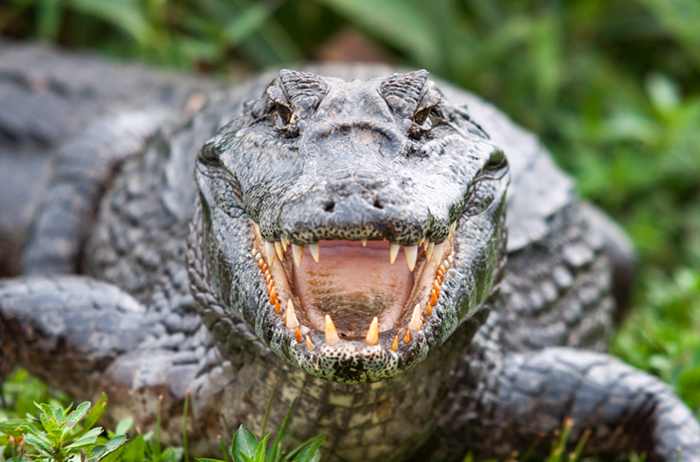VETERINARIAN AND WILDLIFE rehabilitator Janette Ackermann opens the door of her aging freezer and pulls out a snack. It's a plastic container filled with frozen mice.
"We feed them to the birds," she says, "and sometimes the raccoons."
Just 30 miles from downtown Portland, Ackermann's American Wildlife Foundation center in Molalla is nestled between a polymer factory, a glass factory, and lots of farmland. The nonprofit's 13.5-acre lot is mostly wide open, with animal pens scattered here and there. This is the spot where, for the past 14 years, the vet and her staff have treated hundreds of animals before releasing them into the wild. Right now, the facility's pens house needy wildlife ranging from raccoons to birds of prey. But what you won't find on Ackermann's lot are invasive species—or nonnative animals deemed harmful by the state—of any kind.
By law, if a tearful child or big-hearted adult shows up with an injured invasive, be it a cute squirrel or a nasty possum, Ackermann must either turn the thing away or put it to death.
"I have the rules," says Ackermann, "whether I believe in them or don't."
For years, Ackermann and other wildlife rehabbers were exempt from state laws regulating—and targeting—invasive species. But not anymore. Last year, Oregon not only made it illegal for rehabbers to help invasives, but it also began forcing them to euthanize any animals that are taken in. The change is an extension of past state policy, which allowed for the wholesale slaughter of certain invasive species, like feral pigs. But for rehabbers, who put a premium on animal welfare, sharing this burden with the Oregon Department of Fish and Wildlife (ODFW) has been a bitter shift.
"We're animal welfare people; we're not animal control people," says Mary Bliss, who operates Turtle Ridge Wildlife Center in Salem. "Unless they can come up with a big plan to eradicate all these species, then it shouldn't be up to us to have to go against our mission."
Invasive species are any nonnative animals or plants that, once introduced to an environment, cause economic or ecological harm. And they're everywhere. The exact number in Oregon is unknown, but Lisa DeBruyckere from Oregon Invasive Species Council (OISC) estimates there are at least 1,000 non-native animal and plant species preying on or competing with natives—costing the state hundreds of millions of dollars in damages.
Many of these are plants that, a 2008 OISC study estimates, cost the state about $125 million each year. But it's the invasive animals that have caught the public's imagination.
To stop their spread, the ODFW has tried outright eradication—like with the feral pigs—or, better still, keeping invasives out of the state to begin with. But for every invasive pig or hydropower-wrecking mussel, there are hundreds of other species who aren't on the state's kill list, at least not until they wind up at a rehab facility. Many are so well established and familiar that some rehabbers argue that they should get off the euthanasia hook altogether.
The first species rehabbers hope to save is the Virginia opossum, introduced to the Northwest roughly 100 years ago as a food source. Oregon has no extermination policy for the notorious marsupial known for dining on the eggs of native birds. And while possums are ugly, they do have their fans. Rehabbers also want to spare the now-ubiquitous eastern fox squirrel and the eastern gray squirrel, species that have displaced the state's native Douglas and western gray squirrels thanks to the region's expanding urbanization.
In Portland, eradication would mean clearing the city's tree canopy of fluffy-tailed mammals. And because these invaders are small, cute, and endemic in urban Oregon—and because many Oregonians don't know they're invasive—they frequently show up at rehab centers, carried in the arms of would-be do-gooders. That's when Ackermann has to tell them why she won't take them in. "Because I don't have a stomach for mass euthanasia."
It's a tough conversation, she says. "People don't see an invasive; they only see an animal that needs their help."
Under the new rules, wildlife rehabbers basically have two choices: ignoring a sick or injured animal or putting it to death. Choosing a different option could cost a rehabber's license.
Bliss, the operator of the Turtle Ridge Wildlife Center in Salem, was one of 10 rehabbers who, in June 2010, helped ODFW craft the new rules. She told the Mercury she tried to keep ODFW from making euthanasia mandatory at rehabilitation centers, but that the agency had no intention of bending about the rule.
ODFW biologist Keith Kohl says the policy isn't about punishing rehabbers or making them do the agency's work. It's about setting an invasive species policy for the whole state. For years, private animal control companies have been required to euthanize any invasives they caught. But until June 2011, wildlife rehabbers were exempt from the same policy.
"There were some that didn't like it," says Kohl. "But part of their option is they don't have to take these animals in."
And he's right: Rehabbers and the public can always have ODFW do the killing for them.
"The whole thing about euthanasia becomes an emotional one and an ethical one," says ODFW biologist Susan Barnes. "It's not something I take lightly or that the agency takes likely."
Barnes has the unenviable job of euthanizing the animals that rehabbers turn away. The process is similar to what happens when, say, your dog or cat is put down with anesthesia. But for animals with metabolisms too slow to succumb to the chemicals the state uses, like turtles—it gets more involved.
When she spoke to the Mercury, Barnes had just received an invasive red-eared slider turtle, which she was going to euthanize. The procedure is gruesome enough that she asked us not to print it. But Kohl explained the national turtle-killing guidelines that ODFW follows: Biologists have to cut off the animal's head, and then scramble its still-active brains.
Euthanizing invasives isn't pleasant or easy, says Barnes, but she says it's necessary.
"As an agency, our role is to protect our fish and wildlife. And if something needs to be eradicated, we are going to do it and employ humane methods based on science."
Bob Sallinger, conservation director of the Audubon Society of Portland, also thinks the rehabbers are missing the bigger ecological picture. Invasives cause ecological harm, says Sallinger, and regardless of whether or not the state is actively eradicating them, they shouldn't be given the same status as natives.
"We're a conservation organization that also does rehab, so we look at things a little differently," says Sallinger.
Portland's Audubon is one of a handful of wildlife rehab operations in the state that do actively euthanize invasive animals. In fact, it's been Audubon's policy since the early 1980s. And while Salinger says he's sympathetic to the rehabbers' distaste for killing, he says their priority should be protecting native wildlife.
"A lot of these species are doing significant damage to imperiled native species," he says.
But Sallinger is also realistic that euthanasia does very little to stop the spread of foreign species, and admits Audubon's policy—which, like other rehabbers, leaves the decision to euthanize up to people who bring animals in—is more about taking a "philosophical" stance against invasives than actively eradicating them. "I think the best argument [rehabbers] have," says Sallinger, "is what difference does one more make—when there is a hell of a lot of them out there?"
ODFW also acknowledges that killing invasives brought in by the public isn't going to stop their spread. "Is euthanizing one possum that comes into rehab going to rid the state of possum?" says Kohl. "No, but it's the mindset we have to get."
That mindset doesn't seem to be setting in with many rehabbers who still insist the state is asking them to fight its losing battle.
For this reason, a number of rehabbers who spoke with Mercury tried to downplay the harm wrought by the Virginia opossum and the eastern gray and fox squirrels. Instead, they blame native animals' plight on habitat loss and urbanization, something that even advocates of euthanasia admit is a larger problem. And the rehabbers might have a point. There aren't a lot of studies quantifying exactly how these animals are affecting their native counterparts—and whether, as many rehabbers claim, the damage is already done.
And maybe, says Ackermann of the refuge center in Molalla, the dispute may go even deeper than science.
"They [invasives] do cause problems," says Ackermann. "Anyone who thinks they don't cause problems is sticking their head in the sand." But then she continues, "Having said that, I can't euthanize them either."



















